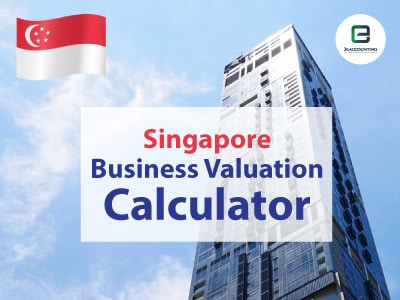How To Value A Business?

A business value can be estimated based on revenue multiple, EBITDA multiple, Price-to-Earnings multiple, Dividend Yield and Discounted Cash Flow. The business valuation process can be time-consuming and complicated, but with our functional business valuation calculator, valuating valuing a business can be simple too!
Table of Contents
How to Determine a Business Valuation in Singapore
Determining a business valuation in Singapore involves a thorough analysis that includes mathematical calculations, in-depth research, and estimates. While each valuation method has unique aspects, the underlying principle remains consistent: to provide an objective assessment of the business’s worth. The choice of method often depends on the specific questions the valuation aims to answer and the scope of the research involved. Here are the main business valuation methods commonly used in Singapore:Methods of Business Valuation in Singapore?
Revenue Multiple
Valuation of business can be based on revenue and multiples of revenue are available for most firms. Revenue multiples is one of the most popular multiples used across industries as it is often difficult to manipulate revenue figures. The standard revenue multiple is 2 times, whereas revenue multiple is about 3 times for fast growing businesses and high growth technology companies.Even though multiples of revenue are simple-to-use metrics of company value, there are limitations as a generic revenue multiple does not define a practice’s value and can be a poor indicator of value – two companies with the same revenue can have a large difference in their operations. However, the revenue multiple becomes highly relevant, especially when a company has a negative EBITDA, making the EBITDA multiple less applicable. New startups on the internet and e-commerce business sectors will generally have negative EBITDA in their initial years – hence it is recommended to use revenue multiple instead for such cases.
EBITDA Multiple
EBITDA can be another starting point for determining business valuation and is one of the most regularly used multiples cum valuation tools. EBITDA or Earnings Before Interest, Tax, Depreciation, and Amortization is the net income derived from operations before non-cash expenses, income taxes, and interest expenses. It reflects the profitability and is indicative of the financial position of the company prior to uncontrollable or non-operational expenses. The default EBITDA multiple is 10 - commonly interpreted as healthy by business analysts and investors. It is often in the range of 6 times to 15 times. It acts as a proxy for free cash flows.Price-to-Earnings Multiple
P/E multiple (also known as Price-to-Earnings multiple) is another well-known business valuation metric, and is also sometimes referred to as the price multiple. It takes into consideration the current market price per share in the numerator and earnings per share in the denominator. It reflects how much investors are willing to pay per dollar of earnings. Generally, a high P/E ratio indicates that investors are expecting higher business growth rate. The current average market P/E multiple is roughly 20 to 25 times (by default, 20 times), and the multiple usually ranges from 12 times to 30 times.Dividend Yield
Dividend yield can be used to value a business but is a lesser-known valuation method that has proven to be reasonably effective. It reflects the relationship between the dividend and the share price. This approach is more appropriate for minority investors in a company because minorities receive dividends and have no access to earnings. Dividend yield analysis works best with companies that have a meaningful yield of roughly 2% or greater than or equivalent to the market yield. The average market dividend yield is around 4%. However, this is only an estimated value and varies depending on the different industries. For companies with stable business models with no significant change over time, dividend yields tend to revert to the mean.Discounted Cash Flow
Discounted cash flow (DCF) is a popular method used in feasibility studies, corporate acquisitions, and stock market valuation. This method is based on the theory that an asset's value is equal to all future cash flows derived from that asset. These cash flows must be discounted to the present value at a discount rate representing the cost of capital, such as the interest rate.DCF has two major components: forecast period and terminal value. The forecast period is usually about five years. Anything longer than that and the accuracy of the projections suffer. This is where calculating terminal value becomes important.
Terminal Value (TV) is the present value of all future cash flows. It is the estimated value of a business beyond the forecast period when future cash flows can be gauged. It forms a large percentage of the total value of a business and there are 2 approaches to computing the TV: 1) Perpetual growth: Used by academics 2) Exit multiple: Used by industry
Perpetual Growth (Gordon Growth Model)
Under the perpetual growth approach, the forecast period is typically 5 years for a normal business because this is a reasonable amount of time to make detailed assumptions. EBITDA acts as a proxy for free cash flows to the firm. Weighted average cost of capital or discounted rate also forms part of the formula to calculate a Terminal Value. This approach assumes that the business will continue to grow at a fixed growth rate. This approach is typically used for companies which are mature in the market and have stable growth.
FCF = Free cash flow for the last forecast period
g = Terminal growth rate
d = discount rate (which is usually the weighted average cost of capital)
Exit Multiple
Exit multiple approach uses market multiple bases to value a business and it is more commonly used by industry professionals as they prefer to compare the business value to something observable in the market. Under this approach, the terminal multiple cum trading multiple can be any usual multiples used in financial valuation like the EBITDA multiple. For example, if a business is trading at 10 times the EBITDA multiple, then the terminal value is 10 * EBITDA of the company.
Valuation Made Simple!
Valuation based on Revenue Multiple
| REVENUE ($) | |
| REVENUE MULTIPLE | |
| Business Value based on Revenue Multiple ($) |
Valuation based on EBITDA Multiple
| EBITDA ($) | |
| EBITDA MULTIPLE | |
| Business Value based on EBITDA Multiple ($) |
Valuation based on P/E Multiple
| ANNUAL NET PROFITS ($) | |
| PREFERRED DIVIDEND ($) | |
| P/E MULTIPLE | |
| Business Value based on P/E Multiple ($) |
Valuation based on Dividend Yield
| ANNUAL DIVIDEND ($) | |
| MARKET/ BENCHMARK DIVIDEND YIELD (%) | |
| Business Value based on Dividend Yield ($) |
Valuation based on Discounted Cash Flow
| WACC / DISCOUNT RATE (%) | |
| GROWTH RATE (%) | |
| FORECAST PERIOD | 5 |
| FORECAST FREE CASH FLOW YEAR 1 ($) | |
| FORECAST FREE CASH FLOW YEAR 2 ($) | |
| FORECAST FREE CASH FLOW YEAR 3 ($) | |
| FORECAST FREE CASH FLOW YEAR 4 ($) | |
| FORECAST FREE CASH FLOW YEAR 5 ($) | |
| TERMINAL VALUE - PERPECTUAL GROWTH MODEL (GORDON GROWTH MODEL) AT YEAR 5 ($) | |
| Business Value based on Discounted Cash Flow ($) |
Disclaimer: The valuation computed above is merely based on information and assumptions provided by you regarding your goals, expectations and financial situation. The calculations provided should not be construed as professional financial or valuation advice.

Get an Accurate Valuation for Your Business with 3E Accounting
Gain insights into your business's true value with expert valuation services. Our team will provide you with precise, actionable information to support your growth and decision-making.
Know Your Business Value Today!

